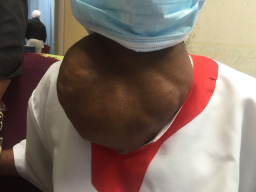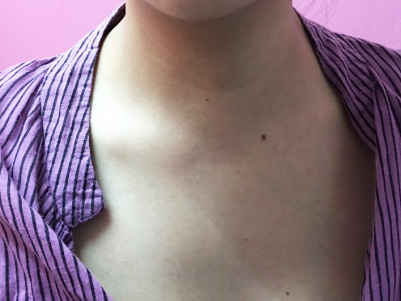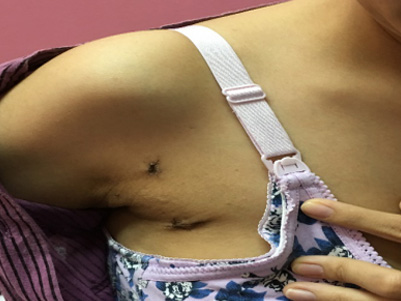What is the thyroid gland?
The thyroid gland is a butterfly shaped endocrine gland in the neck located in front of the wind pipe(trachea). It produces hormones that regulate how the body uses and stores energy. A normal thyroid gland cannot be seen or felt. An enlargement of the thyroid gland is known as – “goitre”.
What is Goitre?
Goitre is the swelling of the neck due to enlargement of the thyroid gland.

Causes and Risk Factors
Under the control of thyroid-stimulating hormone (TSH) from the pituitary, the thyroid gland produces thyroid hormones thyroxine (T4) and triiodothyronine (T3). Thyroid hormones affect metabolism, heat production as well as growth and development.
Disorder of the thyroid, like all endocrine glands, can lead to the following:
- Goitre – gland swelling
- Hyperthyroidism – increased production of thyroid hormones
- Hypothyroidism – reduced thyroid function
The chance of a nodule being cancerous is low – around 5%, but the risk of it becoming cancerous is higher if the nodule grows in size or the patient is previously exposed to ionising radiation etc.
Symptoms
- Swelling at the front of the neck that moves upwards with swallowing. The enlargement can affect all parts of the gland (diffuse) or be seen or felt as lumps (nodule – single or multiple / multinodular).
- Patients with goitre can have normal thyroid function (euthyroid) and can result from iodine deficiency, present with hyperthyroidism (eg. Graves’ disease or diffuse toxic goitre, toxic multinodular goitre) or be hypothyroid (eg. Hashimoto’s thyroiditis).
Diagnosis
- Examination of the swelling
- Blood tests for TSH levels
- Ultrasound scan
- Fine needle aspiration cytology (FNAC), if necessary
Treatment
Not all nodules, single or multiple need to have surgery unless there is high likelihood of cancer or causing pressure symptoms on other organs in the neck.
What is hyperthyroidism?
Hyperthyroidism is the increased production of thyroxine hormones by the thyroid gland.
Causes and Risk Factors
Under the control of thyroid-stimulating hormone (TSH) from the pituitary, the thyroid gland produces thyroid hormones thyroxine (T4) and triiodothyronine (T3). Thyroid hormones affect metabolism, heat production as well as growth and development.
Disorder of the thyroid, like all endocrine glands, can lead to the following:
- Goitre – gland swelling
- Hyperthyroidism – increased production of thyroid hormones
- Hypothyroidism – reduced thyroid function
- The most common cause of hyperthyroidism is Graves’ disease (autoimmune hyperthyroidism). Hyperthyroidism can also arise from functioning nodules within the thyroid. A blood test with raised thyroid hormones and suppressed TSH confirms the diagnosis of hyperthyroidism.
The chance of a nodule being cancerous is low – around 5%, but the risk of it becoming cancerous is higher if the nodule grows in size or the patient is previously exposed to ionising radiation etc.
Symptoms
- Weight Loss
- Palpitations
- Excessive Sweating
- Anxiety
- Breathlessness
- Leg Swelling
Treatment
Anti-thyroid drugs for 12 to 18 months, depending on condition
- Surgery
- Radioactive iodine (RAI)
RAI may be best choice in those with heart disease
What is a Thyroidectomy?
Thyroidectomy is a surgical procedure to remove all or part of the thyroid gland and used to treat diseases of the thyroid gland including:
- Goitre (any non-neoplastic swelling of the thyroid gland is classified as goitre)
- Single swelling (Solitary nodular goitre)
- Multiple swellings (Multinodular goitre)
- Graves disease
- Thyrotoxicosis
- Carcinoma
– Follicular carcinoma
– Papillary carcinoma
– Rare varieties
A thyroidectomy is traditionally performed through a small horizontal incision in the front of the neck. The entire thyroid gland may be removed or just a single lobe, a portion of a lobe and the isthmus or other structures. Depending on the extent of the operation, patients may need to take the drug levothyroxine, an oral synthetic thyroid hormone. The parathyroid glands are normally left in place when the thyroid gland is operated on but their function may be affected by the operation.
a) Total thyroidectomy – Removal of the whole thyroid gland
b) Hemi thyroidectomy – Removal of half the thyroid gland including the middle part called the isthmus.
c) Endoscopic thyroidectomy – Minimally invasive thyroid surgery without scarring in the neck.


Patients suitable to undergo Endoscopic Thyroidectomy
- Patients concerned with cosmetics.
- Unilateral lesions.
- Relatively small thyroid nodule (<4cm)
- Benign conditions.
- Papillary micro-carcinoma in 1 lobe(<1cm)
Advantages of Endoscopic Thyroidectomy
- No scars in the neck
- Less sore throat after surgery
- Just as safe as the open procedure
- You can continue wearing clothes with low necklines
- No one will know you have had a thyroid operation!
However, not all cases are suitable for endoscopic thyroidectomy. Some cases are better done using conventional thyroid surgery.
What are the risks of the operation?
There are three main risks for total thyroidectomy.
- Recurrent laryngeal nerve injury: This nerve controls your vocal cords and if injured you will have a hoarse voice. There is a 2% chance of permanent hoarseness and a 5% chance of temporary hoarseness (< 6months).
- Low blood calcium: There are parathyroid glands that lie behind your thyroid gland that help to control your blood calcium levels. If they are injured or removed (can lie within the thyroid gland) during your operation, then your blood calcium can be too low. This would require you to take calcium and vitamin D supplementation. There is a 1% chance of permanent calcium supplementation and 5% chance of temporary calcium supplementation.
- Bleeding: There is a 1/300 risk of bleeding with your operation. This is the main reason you stay overnight in the hospital.
